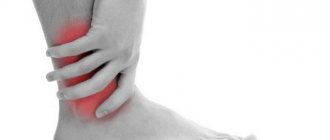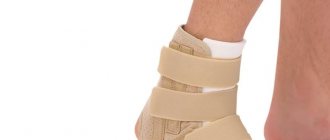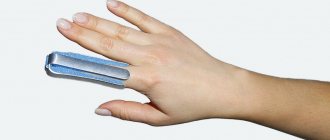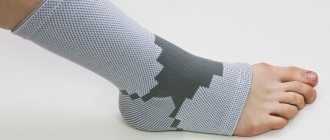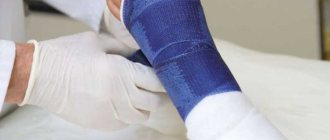We are all accustomed to the fact that for fractures the doctor prescribes plaster. However, now on the medical goods market you can find a more practical and convenient alternative - orthoses.
Orthoses are therapeutic and prophylactic products that are worn for injuries of varying complexity: from sprains and dislocations to joint injuries and fractures. They are made from hypoallergenic and softer materials than plaster. They are:
- for the knee joint
- for the shoulder joint
- on your finger
- wrist
- ankle
- elbow
Plaster is a universal product because it is molded into a certain shape that is needed in a particular case. While the orthosis is more functional and comfortable.
Now we will review and compare both products and help you decide which is better to choose - a cast or an orthosis.
“Everything we talk about next is for informational purposes only and is not practical advice. Before replacing a cast with an orthosis, ALWAYS consult a traumatologist or orthopedist.”
Gypsum: pros and cons of use
Plaster is the most common orthopedic product for fractures. Because it has a number of important advantages:
- Low cost
- Availability - available in any hospital, traumatology and clinic
- Reliable bone fixation
This is where the advantages of gypsum end.
But there are many more shortcomings.
- Unattractive appearance - bulkiness and rapid contamination.
- Uncomfortable to wear under clothing or with shoes.
- Constantly rubs and almost completely limits the movement of the injured limb.
- It is destroyed upon contact with water, which makes it difficult to take a shower or bath comfortably.
- Inability to take an x-ray or necessary medical procedures.
- Prolonged wearing of a cast negatively affects joints, muscles, tendons and impairs blood circulation in the damaged area. Partial muscle atrophy often occurs, so after removing the cast the limb has to be developed.
Now let's look at how things are with orthoses.
Ankle joint
Before moving on to the therapeutic indications and methods of using the bandage, it is necessary to understand the structural features of the ankle joint.
The main elements that provide stability and motor function are ligaments. Anatomically they are divided into three types:
- ligaments of the tibiofibular joint;
- external side;
- deltoid (inner lateral).
Ligaments securely connect all the bones of the ankle and foot and distribute the load between them. This allows a person to maintain balance and perform various types of physical activity.
However, the ankle is often subject to various injuries, the causes of which can be both external physical factors (bruises, sprains, fractures, dislocations) and consequences caused by diseases.
Each type of lesion requires an individual approach for effective therapy. The sooner the doctor makes the correct diagnosis and prescribes treatment, the faster the joint will return to normal. After all, ankle injuries completely knock a person out of the natural rhythm of life and increase the risk of developing associated negative health consequences.
Structure of the human ankle joint
Orthoses: advantages and disadvantages of use
The advantages of orthoses include the following.
- Preservation of motor activity of the injured limb.
- Possibility to adjust the degree of fixation of the product.
- Convenient use - for example, some models allow you to wash with them, since the materials do not absorb water or dry very quickly.
- The ability to carry out any medical manipulations at the fracture site or take an x-ray.
The advantages of orthoses are more significant than those of plaster. However, they are not without drawbacks.
- Not suitable for treating open ankle fractures.
- There is always a risk of an allergic reaction to the orthosis material.
- With prolonged wear, muscle atrophy is possible.
- Only a doctor can choose an orthosis correctly.
- High cost of the product.
We also note that an incorrectly selected orthosis can cause a lot of discomfort for the entire period of wearing it. And then the difference from plaster will not be so noticeable.
Description of the device
Fixed ankle splint
An ankle joint orthosis is a product in the form of a boot or sock that completely replicates the anatomical structure of the leg. Often the patient's fingers remain exposed. The main function of the ankle brace is to provide rigid fixation of the damaged area in the required position. There are also options when the work of the joint is partially limited. The degree of fixation depends directly on the conditions of the pathology. Manipulations with securing the orthosis are carried out thanks to adjustable Velcro, laces, belts or other components. The types of fasteners are determined by the model of the device.
The main design features of ankle orthoses are ease of use, absolute hypoallergenicity and the ability to allow air to pass through. This provides comfort and significantly accelerates the healing of injured tissue, eliminating the risk of developing concomitant pathologies.
Indications for wearing orthoses
If everything is clear with plaster, then it’s worth telling a little about the indications for the use of orthoses.
So, orthoses are worn in the following cases.
- For fractures of extremities, except open fractures.
- During the rehabilitation period after surgery, for example, on a joint.
- Chronic or other diseases: arthritis, arthrosis, ankle dysplasia, paralysis, etc.
- In case of incomplete healing of the damaged limb, for example, after removing a cast.
- In case of sprain or rupture of ligaments, tendons, joints.
We would also like to note that orthoses are not always worn for any injuries or illnesses. They are worn before playing sports or heavy physical work to eliminate the risk of injury.
Derotation boot: product features
A derotational boot is used for fractures of the femoral neck and leg injuries to eliminate the possibility of rotation of the ankle joint (or the entire leg) around its axis. Previously, gypsum splints were used as derotational products. Modern technologies are now used to fix the limb in a certain position. A derotation boot is lighter and more comfortable compared to a plaster splint. It is especially convenient after operations, as it allows doctors to monitor the condition of the sutures and carry out the necessary procedures. The design of the derotation boot is made in such a way that it can be modeled due to fastening and reinforcing inserts.
So what to choose for a fracture: plaster or orthosis?
Unfortunately, we cannot say what exactly you need to choose in your case. Only your attending physician, orthopedist or traumatologist can answer this question.
If you have a complex injury, such as an open fracture, then you should not refuse a cast. In any case, you will have to wear it for 7 to 10 days. And after this period, you can always change the cast to an orthosis.
And in the end, we would like to remind you once again that before buying an orthosis, consult your doctor.
Well, if you have already done this, and now it’s time to choose and buy an orthosis, then go to our catalog and choose the right model for yourself. We work in Grodno and deliver goods to your home.
Derotation boot: prices
Prices for derotation boots vary, depending on the brand and complexity of the design. Domestic manufacturers have prices ranging from 1,500 rubles to 5,000 rubles. The price of a derotation boot from foreign manufacturers ranges from 5,000 rubles to 15,000 rubles and more.
For example, the price of a derotation boot depending on the manufacturer:
Semi-rigid derotational boot for the ankle joint model F-215 price 1750 rub.
Ankle bandage (derotational) Art.: Trives T-8608 / price 1550 rub.
Ankle brace Ottobock Malleo Sprint 50S3 price 5590 rub.
Ankle orthosis Ottobock Malleo TriStep 50S8 price 15,000 rub.
Plaster that can be wetted
When applying polymer plaster, ask your doctor about its resistance to water. Some types repel water and you can shower with them without any problems. Others are permeable and need to be dried with a hairdryer after getting wet.
The article was checked by Strakhov Maxim Alekseevich - Candidate of Medical Sciences, Associate Professor of the Department of Traumatology-Orthopedics and Military Field Surgery of the Federal State Autonomous Educational Institution of Higher Education Russian National Research Medical University named after. N.I. Pirogov of the Ministry of Health of Russia, Associate Professor of the Department of Traumatology and Orthopedics of the Federal State Budgetary Institution Federal Scientific and Clinical Center of the Federal Medical and Biological Agency of Russia (Moscow).
Correct selection of product
It should be remembered that the choice of orthopedic device for the treatment of ankle injuries determines the speed and effectiveness of treatment. That is why it is necessary to approach the choice of product as responsibly as possible. The main criterion for selecting an ankle orthosis is the size of the leg. However, if when choosing a device it is too tight for you, do not rush to go for a larger size. In this case, it is worth stopping at this model. This is due to the fact that a properly selected orthosis should tighten the ankle as much as possible to ensure fixation and immobility.
Orthopedists most often understand foot size as a combination of the following factors:
- patient's daily shoe size;
- ankle coverage;
- ankle coverage;
- boot coverage.
Remember! Choosing the right ankle orthosis is possible only in the presence of the attending physician. When selecting, all factors of the course of the disease and the characteristics of the patient’s body are taken into account. The wrong choice of product is fraught with many irreversible consequences.
In what cases is it better to choose a plastic orthosis?
During the recovery period, plastic structures do not cause discomfort and make it possible to lead a normal lifestyle. In this case, the damaged area remains firmly fixed.
In most cases, thermoplastic orthoses can be used instead of plaster:
- Modern braces have found application in sports medicine and serve to prevent sprains and other injuries associated with heavy physical activity.
- They are hypoallergenic, so they are well suited for people prone to allergic reactions.
- Orthoses are an excellent replacement for plaster for childhood fractures. In this case, wearing comfort due to the light weight of the structure is of great importance. In addition, some clamps have a wide range of colors, which is especially attractive to children.
- They are preferred by people who are concerned about the aesthetic appearance of fixing devices. In this regard, classic gypsum also loses significantly.
The immobilization properties of orthoses make it possible to effectively cope with the most complex tasks, however, the advisability of using a particular method is determined only by a traumatologist after examining the injury.
Which retainer to choose
If immobilization is required, what is more effective: regular plaster or plastic? Despite the advantages of the traditional method of treatment, such as accessibility, durability and low cost, traumatologists and patients increasingly prefer orthoses.
Plastic fixing structures have a number of distinctive features from classic plaster:
- Orthoses transmit x-rays, which allows you to monitor the quality of bone fusion after injury.
- The “breathable” material of the orthosis does not create a greenhouse effect and provides air exchange and thermoregulation.
- The low-temperature thermoplastic orthosis is a “plaster” that can be wetted. It is easy to maintain hygienically without losing its immobilizing properties.
- They have a high degree of rigidity with relatively low weight.
- If necessary, the shape of the low-temperature plastic product can be adjusted during the treatment process.
Regular plaster is very bulky and has an unattractive appearance. When water gets on it, crumbs are formed, which can rub and irritate the surface of the skin.
Alternative to plaster
A modern material of a new generation is a plastic orthosis. This is a real discovery in medicine and an improved alternative to classic plaster.
This unique medical product is made of low-temperature plastic. It is simulated on the patient’s body at a comfortable temperature. After hardening, the product acquires high strength, which allows it to serve as a reliable fastener. The ease of use of the material allows the procedure to be carried out not only in a medical institution, but also on the road.


